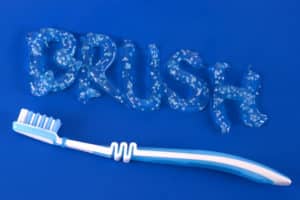Beyond Brushing and Flossing: What More Can You Do?


If you brush and floss your teeth, but you are still getting oral issues like cavities, you may wonder if there is more you can do. Your dentist will always let you know what more you can do in your specific case. However, there are oral health care basics that you can always add into your oral hygiene routine. Those include mouthwash, fluoride treatments, cosmetic dentistry options and more. Here are some tips you can use to go beyond your brushing and flossing!
Brushing and Flossing
Do you brush and floss your teeth every day? Twice a day? The American Dental Association recommends that every person (even infants and toddlers) should brush their teeth at least twice a day or more to keep their mouth healthy. That brushing should be done for at least 2 minutes at a time with ADA-approved toothpaste and a toothbrush that fits the size of the mouth.
Small children and infants will need the help of parents to brush and floss morning and night and will need help flossing once enough teeth come into the mouth. Flossing should be done 1-2 times a day along with brushing, as flossing reaches about 40% of tooth surfaces brushing misses.
Studies have found that at least 3 in 10 millennials only brush their teeth once a day and flossing is done much less often. However, these two habits are key to having a good mouth. You simply can’t skip them if you want to keep your teeth. That’s because your mouth is constantly making plaque when you eat and drink. Sugars in your food and drink will mix with mouth bacteria, creating that sticky, clear film of plaque that coats the teeth.
It can be unsightly without good oral hygiene, but because plaque is so acidic, it will break up the minerals of your teeth and decay them from the inside out. That is how a cavity forms, how infections reach the center of your teeth, how patients end up losing teeth and developing oral health diseases. Skip all those issues with good brushing and flossing at home!

Adding to Your Routine
You may already be a pro at brushing and flossing and still you get cavities. What more can you do? Start adding in other oral health routines! Mouthwash is a great one to add alongside brushing and flossing. Not all mouthwash is the same. Make sure you check labels to see if your mouthwash needs to be diluted before use. Some are meant to freshen breath by killing odor-causing bacteria, while others will be geared towards cavity prevention, treating gum disease or other oral health issues.
Children generally should steer clear of mouthwash, as many types contain alcohol or similar substances that you wouldn’t want a child to accidentally swallow. However, they are completely safe for teens and adults that want to do more than just brushing and flossing. Most brands will prescribe a specific amount of mouthwash that you can measure out in the lid of the mouthwash container. Swish for 30 seconds unless otherwise directed by a label.
You may feel fresher breath already because of the bacteria-fighting action of the mouthwash. Users will want to wait about 30 minutes after mouthwash use to eat or drink. This is because many brands contain fluoride that will work best to protect the teeth if it has had 30 minutes to coat the teeth without food or drink interference.

Fluoride: How Can It Help?
Fluoride is a naturally-occurring mineral found in the earth’s crust. Because of that, fluoride is also found in many foods that grow in the ground such as green leafy vegetables. Public water sources in the U.S. contain fluoride, as the United States government has added it to the drinking water for cavity prevention. Since that addition, the amount of people getting cavities has gone down more than 25%.
Fluoride was originally discovered in the 1930s to be a substance that protected the teeth and reduced the risk of decay from acids and bacteria in the mouth. At dental appointments, your dental cleaning will likely end with a quick fluoride treatment to help strengthen your teeth. For patients that are more prone to cavities (young children, teens, those with oral diseases), treatments may be needed at home. Your dentist can prescribe you fluoride treatments you can easily do at home. However, many mouthwashes and toothpastes will come fortified with fluoride as well.
Visiting the Dentist
Seeing your dentist is perhaps the most important habit you can establish besides brushing and flossing your teeth. That’s because only a dentist is qualified to find the presence of tooth decay, gum disease and other oral diseases and treat them properly. Studies—such as one by the National Institutes of Health—have found that tooth decay is the #1 most “prevalent chronic disease” Americans face. Gum disease is a close second even though this disease affects 64.7 million American adults.
The American Dental Association has made various statements about the importance of dentistry and frequent dental visits. “Frequent” means every 6 months or every 3-4 if you have oral health diseases. These appointments are so important to your health that many insurance plans will cover biannual exams and dental cleanings. However, studies show that only about 65% of people (at least in the U.S.) are actually visiting a dentist each year. Often, that’s only one time. That percentage of people is starting to go down, and children tend to see the dentist even less. It’s no wonder oral health problems affect so many.
If you want to do more for your oral health, make sure you and your family go to your biannual dental visits. Doing so can help your dentist find tooth decay, oral cancer, gum disease, infections and more before they become large or severe. If you have yet to schedule your dental appointment this year, you can do so by calling Dr. Ania’s office at 303-443-0998!


